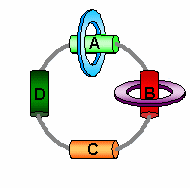The Miniature Rotarians
 | |
David Leigh,
molecular engineer
|
Tiny interlocking wheels are the components of a miniscule molecular rotor designed and built by UK chemists. Two or three small rings rotate around a larger one in discrete steps powered by light, heat, or a chemical stimulus and all heading in the same direction. The submicroscopic invention offers a new motor-like component for those hoping to build nanotechnology from the bottom up.
| |
 |
Follow the rings and you can see the unidirectional motion of the molecular motor
|
The molecular motor consists of two small molecular rings linked onto one larger ring and held in place at predetermined sites, or stations, by hydrogen bonds. The device was designed and built by chemists at the Universities of Edinburgh and Bologna, and it is the hydrogen bonds that act as locking teeth on a molecular ratchet, controlling the movements of the wheels. The small rings are made to move around the big ring by bathing them in light of different wavelengths; the light energy fuels the photochemical reaction to break the hydrogen bonds. Each small ring prevents the other from moving in the opposite direction so they circulate from station to station in one way only in what team leader Edinburgh's David Leigh terms a light-driven directional rotary motor.
The work builds on research into catenanes by Fraser Stoddart and others at the University of California at Los Angeles. "Our work ties in with Fraser's lovely work rather well," says Leigh. "Ours is the first control of directional motion in a catenane, e.g., clockwise motion of components as opposed to random spinning in any direction. Obviously, this is necessary in order to make machines which utilize rotary motion."
 |
A molecular motor could be a revolutionary device in nanotechnology.
Click image to magnify
|
|
| |  |
| Surrounded by "bubbles" of solvent molecules, a molecular motor gets all in a spin.
Click image to magnify |
Leigh suggests that ways to exploit artificial molecular-scale motors are yet to be developed. "Possible future applications could include molecular 'winches' that could wind up polymer chains resulting in length or shape-changes to materials on demand," he says. "They might also be used to power the movement of objects across surfaces, for example, along a path drawn with a laser beam."
University of Edinburgh graduate student Jenny Wong was the researcher who actually designed and synthesized the molecular motor.
"It's an extraordinary molecule," she says. "Imagine how hard it is to thread rings on to a loop that is only a millionth of a millimetre across!" The chemical descendents of these molecules look set for a revolutionary future.
http://www.catenane.net
Nature, 2003, 424, 174-179; http://dx.doi.org/10.1038/nature01758

